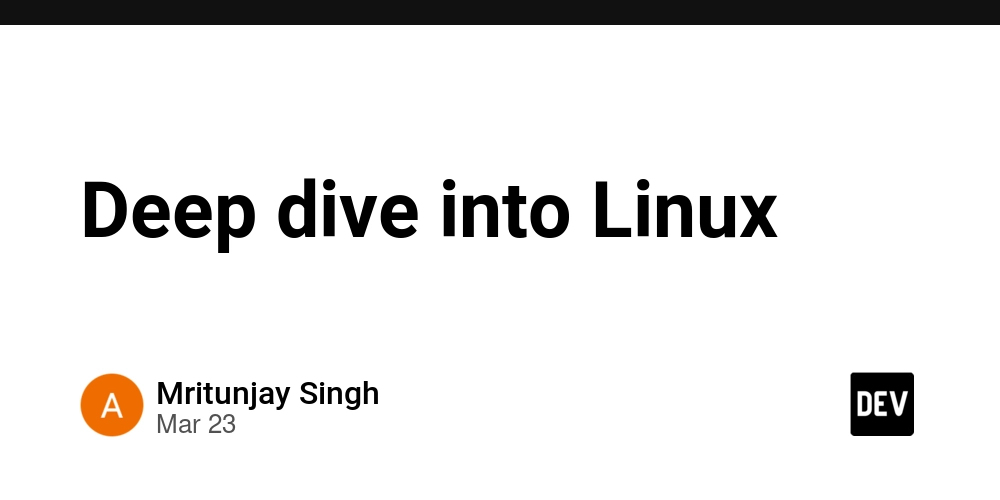Deep dive into Linux
What is Linux Linux is an open-source operating system modeled on UNIX. It was created by Linus Torvalds in 1991 and has grown to become one of the most popular operating systems worldwide, especially for servers and development environments. Windows vs Linux Linux is known for its stability, security, and open-source nature, while Windows is more user-friendly with a large variety of software and hardware support. Linux is preferred in server environments and by developers, while Windows is common on desktops. What is Kernel The kernel is the core part of the operating system that manages hardware resources and facilitates communication between software and hardware. Details of Basic to Advance commands What is Shebang (#!)? Shebang is a special character in Linux used to specify which shell to use to execute the script. It is placed in the very first line of the script, followed by the absolute path of the interpreter that will be used to execute the script. Example: #!/bin/bash Types of Shells Bash Sh Ksh How to check your current shell? To check the current shell, run the following command: echo $SHELL To Change Shell To change the shell: chsh -s /bin/bash What Does ./ Do? The ./ tells Linux to look in the current directory. Without it, Linux only looks for commands in predefined system paths ($PATH). Why is ./ Needed to Run Scripts? By default, Linux does not execute files from the current directory unless you explicitly tell it to. Example: Trying to run a script without ./: script.sh ❌ Error: Command not found bash: script.sh: command not found What If I Don’t Use ./? Option 1: Use Full Path /home/user/myscript.sh Option 2: Add the Script to $PATH If you want to run myscript.sh without ./, move it to /usr/local/bin: sudo mv myscript.sh /usr/local/bin/myscript chmod +x /usr/local/bin/myscript Now, you can run: myscript from anywhere without ./. What Does "Adding a Script to $PATH" Mean? The $PATH variable is a list of directories where Linux looks for executable commands. Why Add a Script to $PATH? If you place your script in one of these directories, you can run it from anywhere without using ./. Example: Move your script to /usr/local/bin/: sudo mv myscript.sh /usr/local/bin/myscript Make it executable: chmod +x /usr/local/bin/myscript Now you can run it from anywhere: myscript How Linux Finds and Executes Commands Example 1: Running ls Command When you type ls, Linux needs to find the ls executable file and run it. Check if ls is a built-in command (e.g., cd is a built-in shell command). Check $PATH directories for ls. To check where ls is located: which ls Output: /usr/bin/ls $PATH and Why It Matters The $PATH variable contains a list of directories separated by : where Linux searches for commands. Example output: /usr/local/sbin:/usr/local/bin:/usr/sbin:/usr/bin:/sbin:/bin Finding Where a Command is Located Use the following commands: which → Shows the full path of an executable which vim Output: /usr/bin/vim type → Tells if a command is built-in or external type cd Output: cd is a shell builtin command -v → Also finds the location of a command command -v node Output: /home/mritunjay/.nvm/versions/node/v20.18.2/bin/node How to Check If a Script is in $PATH Use which to check: which myscript If no output is returned, the script is not in a $PATH directory. History Command in Linux – Deep Dive with Practical Examples Basic Usage of history Simply type: history Output: 1 ls 2 cd /var/log 3 cat syslog 4 nano file.txt 5 history Search Command History Press Ctrl + R to search interactively: Press Ctrl + R Start typing a command (e.g., nano) It will show the most recent match. Press Enter to execute it or Esc to edit. How to Write a Simple Shell Script? Create a file: vim sample-script.sh Add the following script: #!/bin/bash # Create a folder mkdir learning-shell-script cd learning-shell-script # Create two files touch f1 f2 Save and exit: :wq! Make the script executable: chmod 777 sample-script.sh Run the script: ./sample-script.sh You will see the folder learning-shell-script containing f1 and f2. !q vs !wq !q: Quits without saving. !wq: Saves and quits. Other System-Related Commands nproc: Shows the number of processing units available. free: Displays memory usage. top: Displays system tasks and resource usage. Role of Shell Scripting in DevOps Shell scripting plays a crucial role in DevOps automation, a

What is Linux
Linux is an open-source operating system modeled on UNIX. It was created by Linus Torvalds in 1991 and has grown to become one of the most popular operating systems worldwide, especially for servers and development environments.
Windows vs Linux
Linux is known for its stability, security, and open-source nature, while Windows is more user-friendly with a large variety of software and hardware support. Linux is preferred in server environments and by developers, while Windows is common on desktops.
What is Kernel
The kernel is the core part of the operating system that manages hardware resources and facilitates communication between software and hardware.
Details of Basic to Advance commands
What is Shebang (#!)?
Shebang is a special character in Linux used to specify which shell to use to execute the script. It is placed in the very first line of the script, followed by the absolute path of the interpreter that will be used to execute the script.
Example:
#!/bin/bash
Types of Shells
- Bash
- Sh
- Ksh
How to check your current shell?
To check the current shell, run the following command:
echo $SHELL
To Change Shell
To change the shell:
chsh -s /bin/bash
What Does ./ Do?
The ./ tells Linux to look in the current directory. Without it, Linux only looks for commands in predefined system paths ($PATH).
Why is ./ Needed to Run Scripts?
By default, Linux does not execute files from the current directory unless you explicitly tell it to.
Example: Trying to run a script without ./:
script.sh
❌ Error: Command not found
bash: script.sh: command not found
What If I Don’t Use ./?
- Option 1: Use Full Path
/home/user/myscript.sh
-
Option 2: Add the Script to
$PATHIf you want to runmyscript.shwithout./, move it to/usr/local/bin:
sudo mv myscript.sh /usr/local/bin/myscript
chmod +x /usr/local/bin/myscript
Now, you can run:
myscript
from anywhere without ./.
What Does "Adding a Script to $PATH" Mean?
The $PATH variable is a list of directories where Linux looks for executable commands.
Why Add a Script to $PATH?
If you place your script in one of these directories, you can run it from anywhere without using ./.
Example:
- Move your script to
/usr/local/bin/:
sudo mv myscript.sh /usr/local/bin/myscript
- Make it executable:
chmod +x /usr/local/bin/myscript
- Now you can run it from anywhere:
myscript
How Linux Finds and Executes Commands
Example 1: Running ls Command
When you type ls, Linux needs to find the ls executable file and run it.
- Check if
lsis a built-in command (e.g.,cdis a built-in shell command). - Check
$PATHdirectories forls.
To check where ls is located:
which ls
Output:
/usr/bin/ls
$PATH and Why It Matters
The $PATH variable contains a list of directories separated by : where Linux searches for commands.
Example output:
/usr/local/sbin:/usr/local/bin:/usr/sbin:/usr/bin:/sbin:/bin
Finding Where a Command is Located
Use the following commands:
-
which→ Shows the full path of an executable
which vim
Output:
/usr/bin/vim
-
type→ Tells if a command is built-in or external
type cd
Output:
cd is a shell builtin
-
command -v→ Also finds the location of a command
command -v node
Output:
/home/mritunjay/.nvm/versions/node/v20.18.2/bin/node
How to Check If a Script is in $PATH
Use which to check:
which myscript
If no output is returned, the script is not in a $PATH directory.
History Command in Linux – Deep Dive with Practical Examples
Basic Usage of history
Simply type:
history
Output:
1 ls
2 cd /var/log
3 cat syslog
4 nano file.txt
5 history
Search Command History
Press Ctrl + R to search interactively:
- Press
Ctrl + R - Start typing a command (e.g.,
nano) - It will show the most recent match.
- Press Enter to execute it or Esc to edit.
How to Write a Simple Shell Script?
- Create a file:
vim sample-script.sh
- Add the following script:
#!/bin/bash
# Create a folder
mkdir learning-shell-script
cd learning-shell-script
# Create two files
touch f1 f2
- Save and exit:
:wq!
- Make the script executable:
chmod 777 sample-script.sh
- Run the script:
./sample-script.sh
You will see the folder learning-shell-script containing f1 and f2.
!q vs !wq
-
!q: Quits without saving. -
!wq: Saves and quits.
Other System-Related Commands
-
nproc: Shows the number of processing units available. -
free: Displays memory usage. -
top: Displays system tasks and resource usage.
Role of Shell Scripting in DevOps
Shell scripting plays a crucial role in DevOps automation, allowing developers to write scripts for tasks such as deployment, monitoring, backups, and configuration management.










































































































































































![[The AI Show Episode 142]: ChatGPT’s New Image Generator, Studio Ghibli Craze and Backlash, Gemini 2.5, OpenAI Academy, 4o Updates, Vibe Marketing & xAI Acquires X](https://www.marketingaiinstitute.com/hubfs/ep%20142%20cover.png)



























































































































![[FREE EBOOKS] The Kubernetes Bible, The Ultimate Linux Shell Scripting Guide & Four More Best Selling Titles](https://www.javacodegeeks.com/wp-content/uploads/2012/12/jcg-logo.jpg)



![From drop-out to software architect with Jason Lengstorf [Podcast #167]](https://cdn.hashnode.com/res/hashnode/image/upload/v1743796461357/f3d19cd7-e6f5-4d7c-8bfc-eb974bc8da68.png?#)






































































































.png?#)




.jpg?#)
































_Christophe_Coat_Alamy.jpg?#)







































































































![Rapidus in Talks With Apple as It Accelerates Toward 2nm Chip Production [Report]](https://www.iclarified.com/images/news/96937/96937/96937-640.jpg)









































































































































